You are using an out of date browser. It may not display this or other websites correctly.
You should upgrade or use an alternative browser.
You should upgrade or use an alternative browser.
Does anyone have a 105mm sigma and a raynox 250.
- Thread starter AndyG123
- Start date
GardenersHelper
In Memoriam
- Messages
- 6,344
- Name
- Nick
- Edit My Images
- Yes
I have a Sigma 105 Macro that I can put on a Canon 70D. The 70D is 1.6 crop factor vs 1.5 on your D3300, but presumably close enough?
Is it just the difference in magnification with the Raynox 250 (and any vignetting) that you are interested in? If so, i can easily do that.
If you want to compare image quality for real world examples that is more difficult. Don't know if I can find anything suitable that will stay still long enough to use both. I could give you comparisons using my test setup if that would help (a banknote and a focusing chart).
Is it just the difference in magnification with the Raynox 250 (and any vignetting) that you are interested in? If so, i can easily do that.
If you want to compare image quality for real world examples that is more difficult. Don't know if I can find anything suitable that will stay still long enough to use both. I could give you comparisons using my test setup if that would help (a banknote and a focusing chart).
That would be great if you could. A banknote with and without would give me a feel for how the raynox performs and how much more it magnifies.I have a Sigma 105 Macro that I can put on a Canon 70D. The 70D is 1.6 crop factor vs 1.5 on your D3300, but presumably close enough?
Is it just the difference in magnification with the Raynox 250 (and any vignetting) that you are interested in? If so, i can easily do that.
If you want to compare image quality for real world examples that is more difficult. Don't know if I can find anything suitable that will stay still long enough to use both. I could give you comparisons using my test setup if that would help (a banknote and a focusing chart).
Thanks
GardenersHelper
In Memoriam
- Messages
- 6,344
- Name
- Nick
- Edit My Images
- Yes
Here we go. This is the test subject I used.
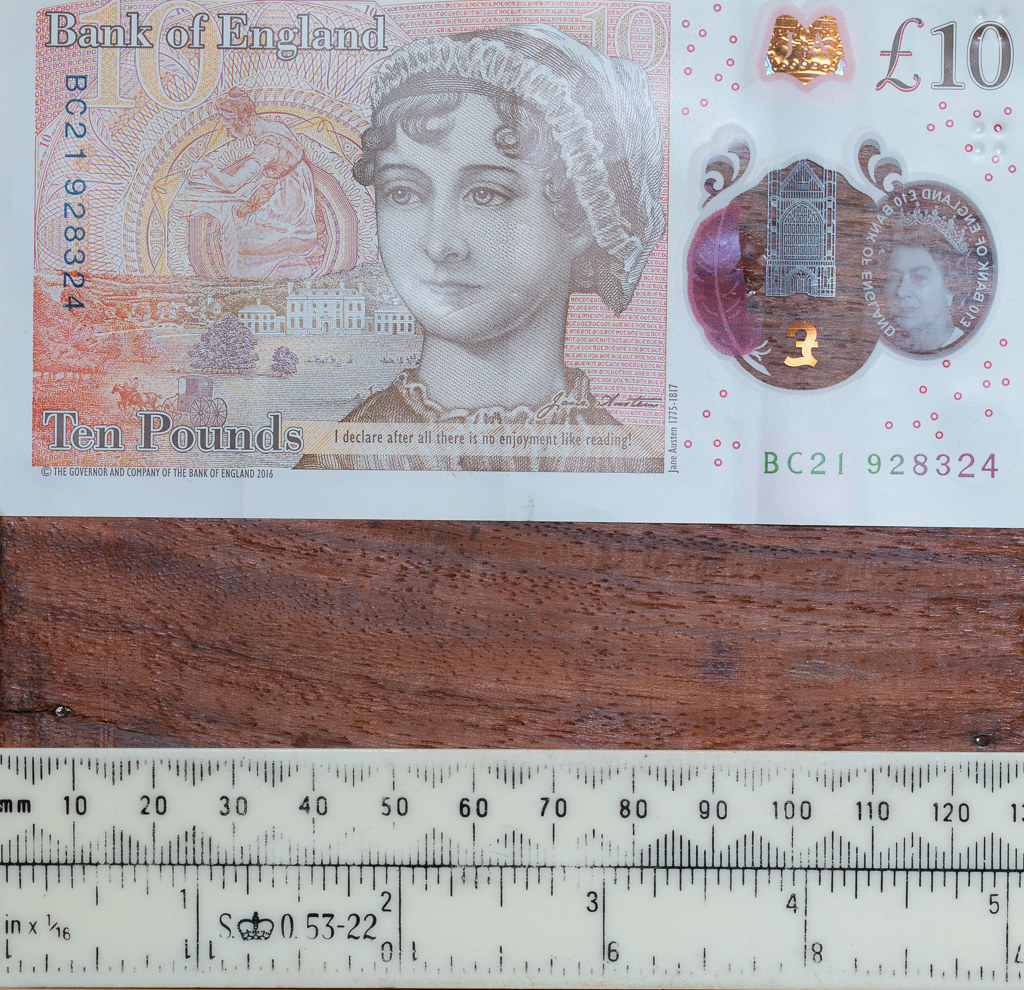
1528 22 The banknote by gardenersassistant, on Flickr
I photographed it at f/4, f/8 and f/16 with a Raynox 250 on a Sigma 105 macro on a Canon 70D, using 6 magnifications ranging from:

1528 23 Sigma105+R250 max, min mag, 105 max mag by gardenersassistant, on Flickr
I shot raw, using flash, with the camera on a tripod and using manual focusing with 10x magnification at the centre of the frame. I imported the raw files into Lightroom using Lightroom defaults. The only adjustment I made to the images was to even up the brightness (more or less). I then exported to JPEG.
The JPEGs are in this album at Flickr. As illustrated below, you can tell which image is which from the filenames.
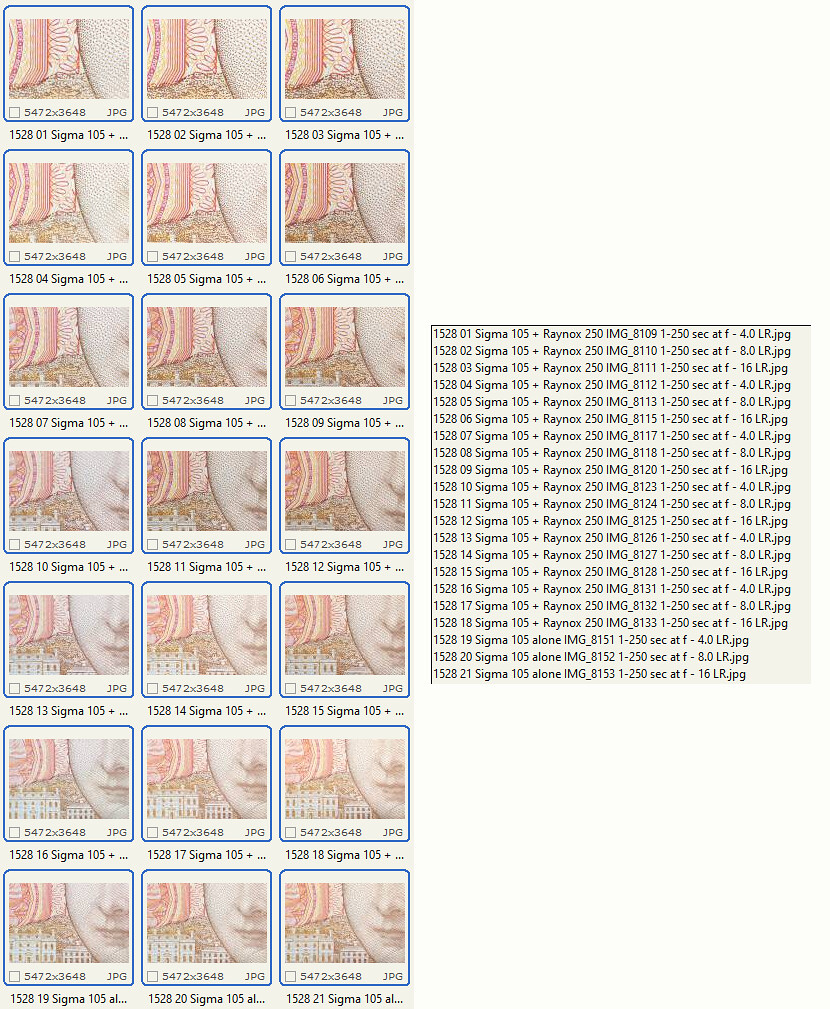
1528 29 Thumbnails and list of test images by gardenersassistant, on Flickr
You will need to examine the images and draw your own conclusions. I will just make a few comments based on my experience of doing this sort of comparison.
One of the comparisons I think makes sense is to compare the Sigma 105 at 1:1 with the Sigma+Raynox at minimum magnification, as they have similar magnification. Here is what the f/8 versions look like at the centre of the frame at 100%. (I have kept to the forum's recommended maximum side length of 1024 pixels, so you might need to look at the full size screenshots over at Flickr to see what I'm talking about. Or better of course, do a comparison for yourself of the full size JPEGs.) These two look similar to me.
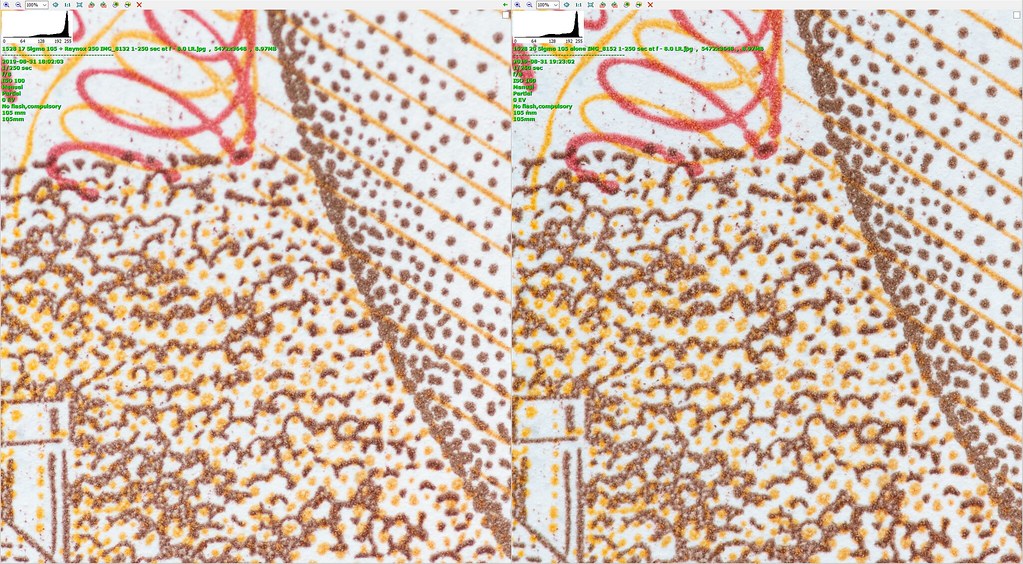 1528 24 Same scene width at 100pc, F8, centre by gardenersassistant, on Flickr
1528 24 Same scene width at 100pc, F8, centre by gardenersassistant, on Flickr
You will also be interested in what it is like as you move away from the centre. Now things start to get complicated I'm afraid. It is (for me at least) extremely difficult to get the subject exactly perpendicular to the lens axis (either horizontally or vertically, let alone both). It is essential therefore not to draw any conclusions from looking at a single edge or corner. You need to look all round the edges and corners.
There is also a wrinkle regarding aperture. With the Sigma 105 at 1:1, the effective f-number on a Canon camera is double the aperture set on the lens. So when you set the lens to f/8, if you are at 1:1 you are actually using f/16. In contrast, a close-up lens does not alter the effective f-number, so when looking at the minimum magnification Raynox image, for which the camera was focused at infinity, with the lens set to f/8 then that is the aperture you are actually using.
Now, depth of field is a key issue for macro, so assuming that you are concerned about what image quality you may get for any particular depth of field, you need to compare the images captured with the same effective aperture. This means that in comparing the maximum magnification Sigma 105-alone image with the minimum magnification Sigma+Raynox image, it makes sense to compare the f/8 Sigma-alone image with the f/16 Sigma+Raynox image (or the f/4 Sigma-alone image to the f/8 Raynox image). Here is what the f/8 to f/16 comparison looks like in the centre of the frame (Raynox version on the left).
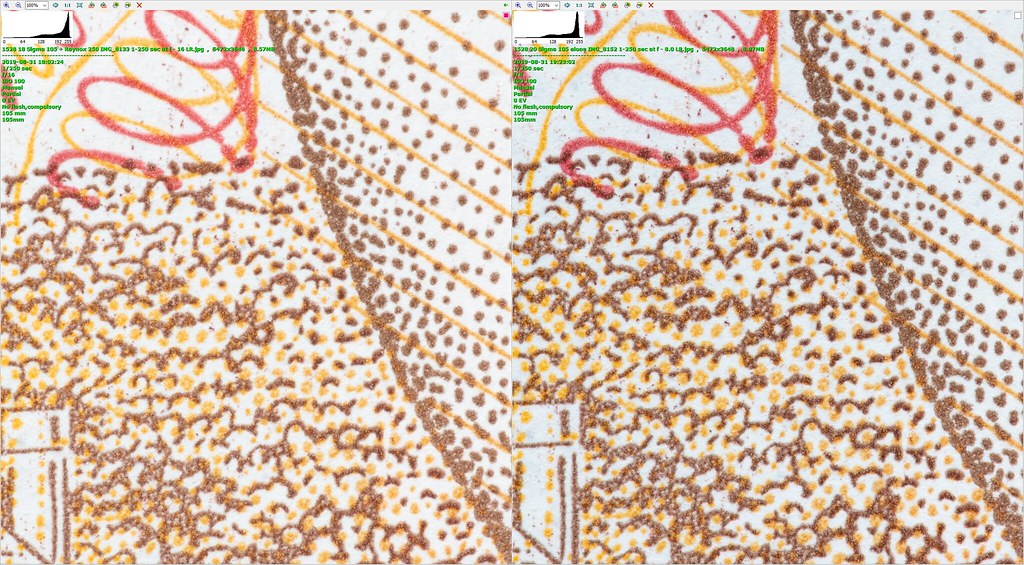
1528 25 Same scene width at 100pc, centre, 105 at F8, R250 at F16 by gardenersassistant, on Flickr
Now look at the bottom left hand corner. The Sigma-alone version looks very soft. You will need to check, but I think three corners are softer in the Sigma-only version. That is a bit of a surprise.
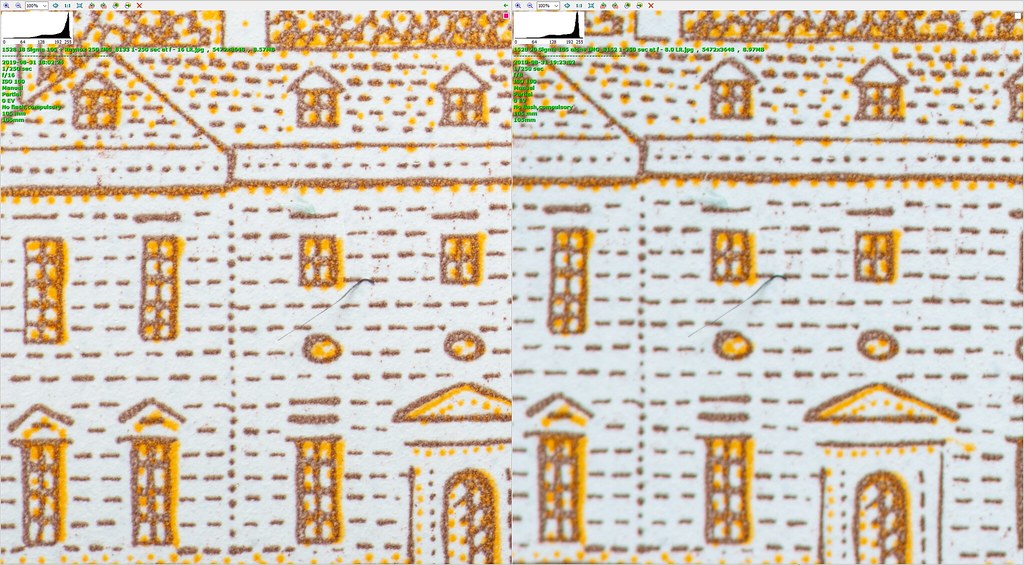
1528 26 Same scene width at 100pc, bottom left, 105 at F8, R250 at F16 by gardenersassistant, on Flickr
Perhaps I'm being unfair here. What if the Sigma-alone was at f/16, would the extra depth of field make it better in the corners? Well, here is what they look like in the centre, both at f/16. The Sigma-only version on the right is much softer than it was at f/8 (which would be the effect of diffraction), and is now softer than the Raynox version.

1528 27 Same scene width at 100pc, centre, Both at F16 by gardenersassistant, on Flickr
And here is the top right corner with both at f/16. Again the Sigma version is softer. Once again you will need to check, but this time all four of the Sigma-only corners look softer than the Raynox corners to me.
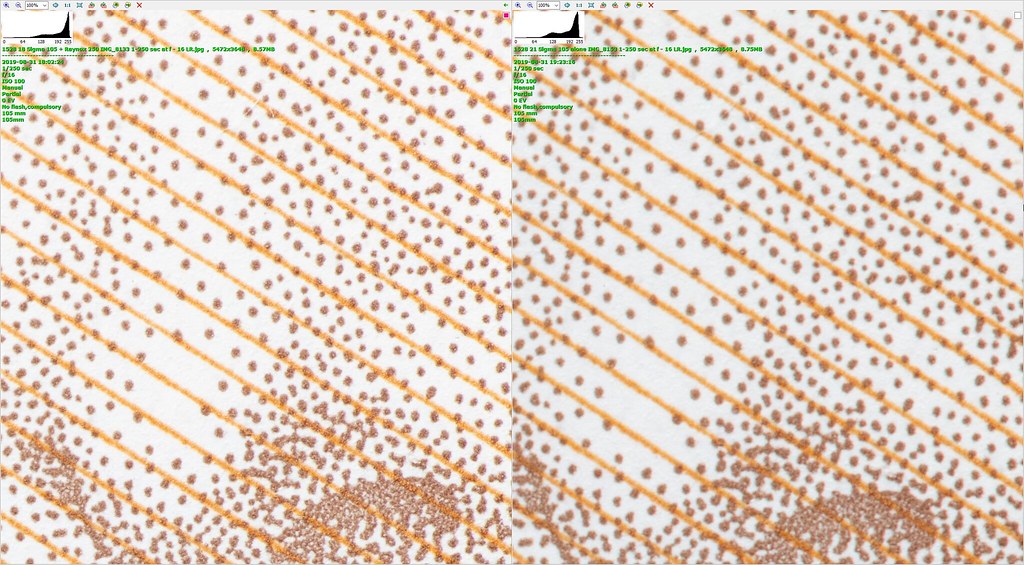
1528 28 Same scene width at 100pc, top right, Both at F16 by gardenersassistant, on Flickr
There are some other ifs and buts and complications, but my point here is simply that if you are going to use test shot comparisons it is, I believe, a good idea to have a very careful look around multiple test shots to try to get a reasonable grip on what can, in my experience, be a bit of a complicated muddle to work out. (One additional muddle factor in this case being that since you use a Nikon camera, the camera may tell you the actual (effective) aperture you are using, increasing the reported f-number as the magnification increases. But I don't know if it does this with non-Nikon lenses, and the Sigma 105 in particular.)
Anyway, I hope you find at least some of this useful.
Oh, a final thought, actually an opinion. I think the image quality with a Raynox 250 is ok, but used on a macro lens the working distance can get rather small. Depending on what you are intending to photograph, that might or might not be a problem.

1528 22 The banknote by gardenersassistant, on Flickr
I photographed it at f/4, f/8 and f/16 with a Raynox 250 on a Sigma 105 macro on a Canon 70D, using 6 magnifications ranging from:
- Minimum magnification (with the Sigma 105 set to focus at infinity, which gave a scene width of around 29mm (around 1:1.3 for the 22.5mm width 70D sensor) at a working distance of around 125mm, to
- Maximum magnification (with the Sigma 105 set to 1:1), which gave a scene width of around 10.5mm (approximately 2:1) at a working distance of around 55mm.

1528 23 Sigma105+R250 max, min mag, 105 max mag by gardenersassistant, on Flickr
I shot raw, using flash, with the camera on a tripod and using manual focusing with 10x magnification at the centre of the frame. I imported the raw files into Lightroom using Lightroom defaults. The only adjustment I made to the images was to even up the brightness (more or less). I then exported to JPEG.
The JPEGs are in this album at Flickr. As illustrated below, you can tell which image is which from the filenames.

1528 29 Thumbnails and list of test images by gardenersassistant, on Flickr
You will need to examine the images and draw your own conclusions. I will just make a few comments based on my experience of doing this sort of comparison.
One of the comparisons I think makes sense is to compare the Sigma 105 at 1:1 with the Sigma+Raynox at minimum magnification, as they have similar magnification. Here is what the f/8 versions look like at the centre of the frame at 100%. (I have kept to the forum's recommended maximum side length of 1024 pixels, so you might need to look at the full size screenshots over at Flickr to see what I'm talking about. Or better of course, do a comparison for yourself of the full size JPEGs.) These two look similar to me.
 1528 24 Same scene width at 100pc, F8, centre by gardenersassistant, on Flickr
1528 24 Same scene width at 100pc, F8, centre by gardenersassistant, on FlickrYou will also be interested in what it is like as you move away from the centre. Now things start to get complicated I'm afraid. It is (for me at least) extremely difficult to get the subject exactly perpendicular to the lens axis (either horizontally or vertically, let alone both). It is essential therefore not to draw any conclusions from looking at a single edge or corner. You need to look all round the edges and corners.
There is also a wrinkle regarding aperture. With the Sigma 105 at 1:1, the effective f-number on a Canon camera is double the aperture set on the lens. So when you set the lens to f/8, if you are at 1:1 you are actually using f/16. In contrast, a close-up lens does not alter the effective f-number, so when looking at the minimum magnification Raynox image, for which the camera was focused at infinity, with the lens set to f/8 then that is the aperture you are actually using.
Now, depth of field is a key issue for macro, so assuming that you are concerned about what image quality you may get for any particular depth of field, you need to compare the images captured with the same effective aperture. This means that in comparing the maximum magnification Sigma 105-alone image with the minimum magnification Sigma+Raynox image, it makes sense to compare the f/8 Sigma-alone image with the f/16 Sigma+Raynox image (or the f/4 Sigma-alone image to the f/8 Raynox image). Here is what the f/8 to f/16 comparison looks like in the centre of the frame (Raynox version on the left).

1528 25 Same scene width at 100pc, centre, 105 at F8, R250 at F16 by gardenersassistant, on Flickr
Now look at the bottom left hand corner. The Sigma-alone version looks very soft. You will need to check, but I think three corners are softer in the Sigma-only version. That is a bit of a surprise.

1528 26 Same scene width at 100pc, bottom left, 105 at F8, R250 at F16 by gardenersassistant, on Flickr
Perhaps I'm being unfair here. What if the Sigma-alone was at f/16, would the extra depth of field make it better in the corners? Well, here is what they look like in the centre, both at f/16. The Sigma-only version on the right is much softer than it was at f/8 (which would be the effect of diffraction), and is now softer than the Raynox version.

1528 27 Same scene width at 100pc, centre, Both at F16 by gardenersassistant, on Flickr
And here is the top right corner with both at f/16. Again the Sigma version is softer. Once again you will need to check, but this time all four of the Sigma-only corners look softer than the Raynox corners to me.

1528 28 Same scene width at 100pc, top right, Both at F16 by gardenersassistant, on Flickr
There are some other ifs and buts and complications, but my point here is simply that if you are going to use test shot comparisons it is, I believe, a good idea to have a very careful look around multiple test shots to try to get a reasonable grip on what can, in my experience, be a bit of a complicated muddle to work out. (One additional muddle factor in this case being that since you use a Nikon camera, the camera may tell you the actual (effective) aperture you are using, increasing the reported f-number as the magnification increases. But I don't know if it does this with non-Nikon lenses, and the Sigma 105 in particular.)
Anyway, I hope you find at least some of this useful.
Oh, a final thought, actually an opinion. I think the image quality with a Raynox 250 is ok, but used on a macro lens the working distance can get rather small. Depending on what you are intending to photograph, that might or might not be a problem.
Last edited:
Thank you very much for the assistance! It's good to know that the sigma and raynox at infinity gives a same size image and great detail similar to the sigma without...
I kind of thought if I'm using it I'd need the raynox either on or off, but I should just be able to move to infinity for it to still 'feel' like my normal macro lens. With obviously the added bonus of going to max zoom giving me a 2:1!
With a 2 year old toddler and a 7 week old baby girl I never have time or the chance to plan for the sunsets or sunrises as life is very busy and everything then has to land in line with both of their naps or wakes, weather and the wife's plans also. It's just a very hard balancing act!
This is just for controlled element things around the house so I'm still shooting during winter as I do find the world of macro fascinating!
I think im a sold man and its on my official birthday list for next Friday now!
Thank you very much for your help! really appreciated.
I kind of thought if I'm using it I'd need the raynox either on or off, but I should just be able to move to infinity for it to still 'feel' like my normal macro lens. With obviously the added bonus of going to max zoom giving me a 2:1!
With a 2 year old toddler and a 7 week old baby girl I never have time or the chance to plan for the sunsets or sunrises as life is very busy and everything then has to land in line with both of their naps or wakes, weather and the wife's plans also. It's just a very hard balancing act!
This is just for controlled element things around the house so I'm still shooting during winter as I do find the world of macro fascinating!
I think im a sold man and its on my official birthday list for next Friday now!
Thank you very much for your help! really appreciated.
GardenersHelper
In Memoriam
- Messages
- 6,344
- Name
- Nick
- Edit My Images
- Yes
I think im a sold man and its on my official birthday list for next Friday now!
Thank you very much for your help! really appreciated.
You are very welcome.
One thing I probably should have mentioned, although I don't know whether it would be relevant to you or not, is that although I do use close-up lenses a lot, I don't use them on macro lenses. I use them on telezoom lenses.
For example, I don't use the 70D for this sort of thing these days, but when I did for several years I used a Raynox 250 and also the less powerful Raynox 150 on an EF-S (smaller, APS-C, like DX) 55-250 telezoom lens. With the Raynox 250 this gave:
- A maximum scene width of around 50mm (magnification around 1:2) at a working distance of around 115mm, and
- A minimum scene width of around 12mm (magnification almost 2:1) at a working distance also of around 115mm.
- A maximum scene width of around 85mm (magnification around 1:4) at a working distance of around 205mm, and
- A minimum scene width of around 20mm (magnification slightly over 1:1) at a working distance of around 195mm.
For insects etc I have for several years now used close-up lenses on micro four thirds cameras and small (1/2.3" sensor) bridge cameras rather than on the 70D.
These days I do use a macro lens (on micro four thirds) for lower magnification close-ups of flowers etc, for which working distances are fine, as is autofocus. The Olympus 60mm macro lens that I use is much, much smaller and lighter than the Sigma 105 and I can use it comfortably all day long, including for one-handed operation and awkward angles.
If you get a Raynox 250, and if you have a telezoom lens, you might want to try the Raynox 250 on it.
I'll be tempted to try with my kit 70-300 should do quite well and maybe my 18-55 with extension tubes and the raynox will be interesting to have an experiment with. Next step... To the show us your DIY flash rig thread! Hahaf you have a telezoom lens, you might want to try the Raynox 250 on it.
GardenersHelper
In Memoriam
- Messages
- 6,344
- Name
- Nick
- Edit My Images
- Yes
I'll be tempted to try with my kit 70-300 should do quite well and maybe my 18-55 with extension tubes and the raynox will be interesting to have an experiment with.
Sounds like good moves. And fun!
Next step... To the show us your DIY flash rig thread! Haha
Flash - LOTS of options there. More fun!

